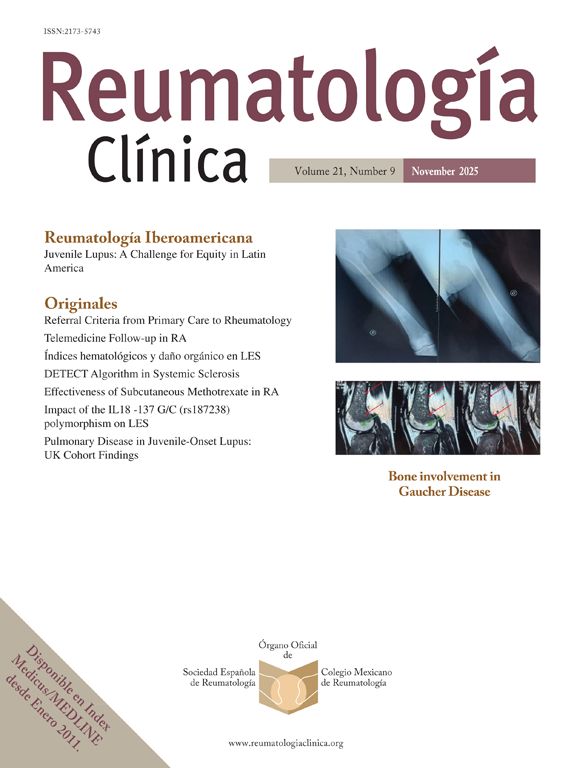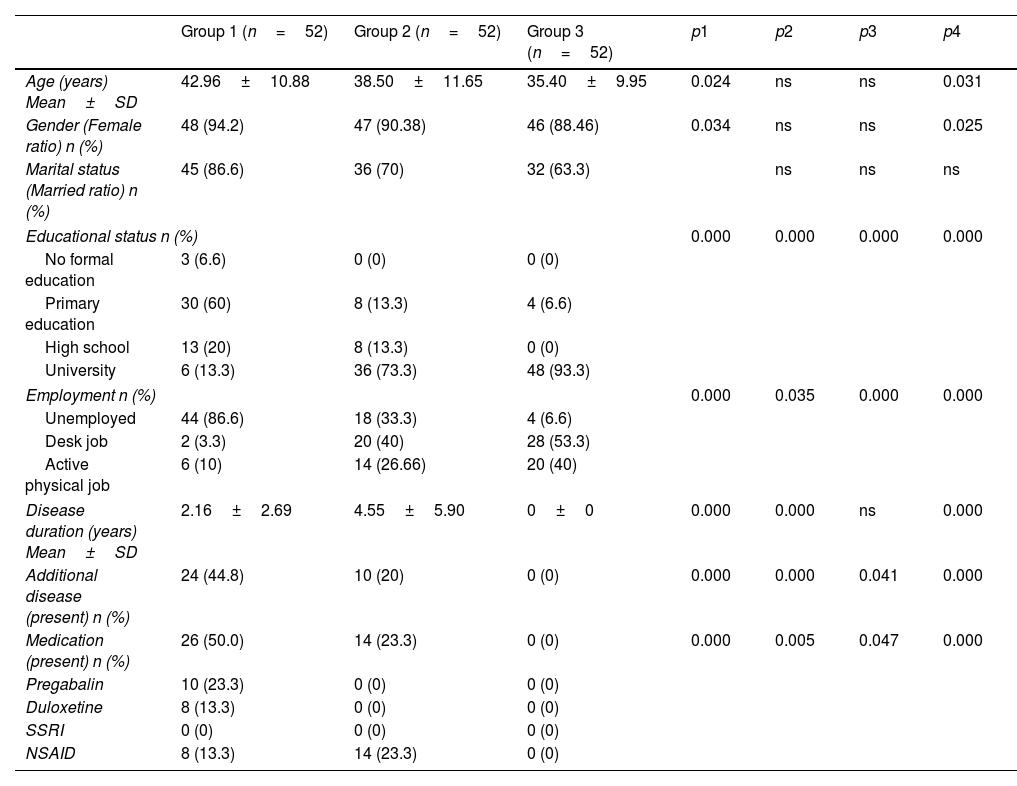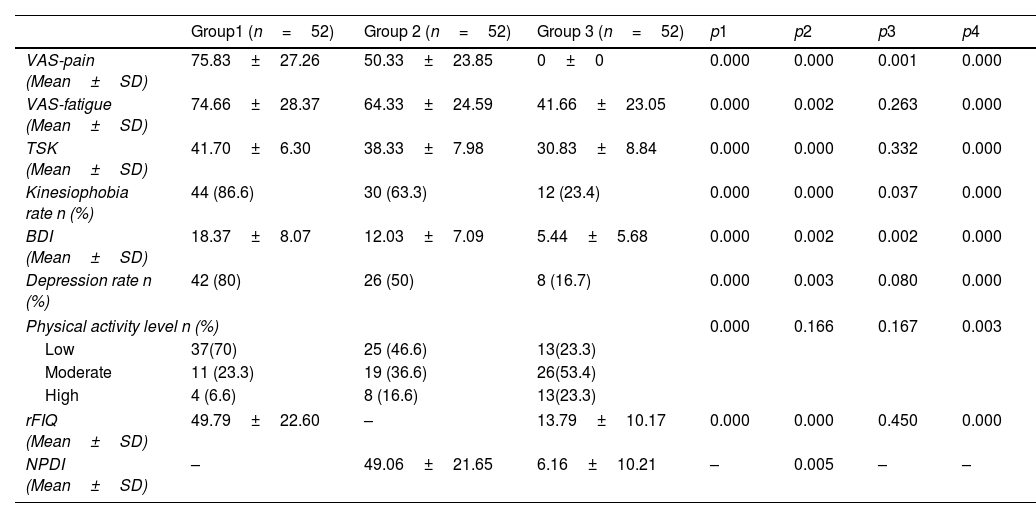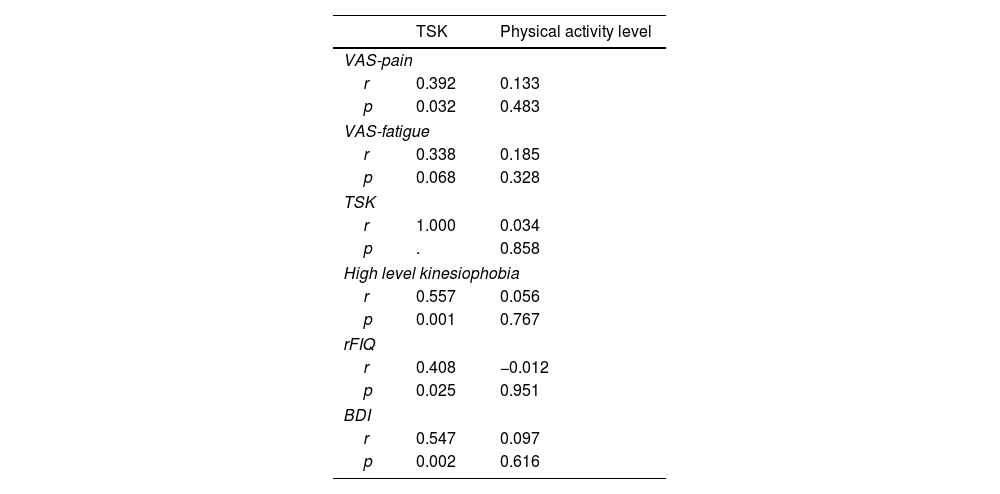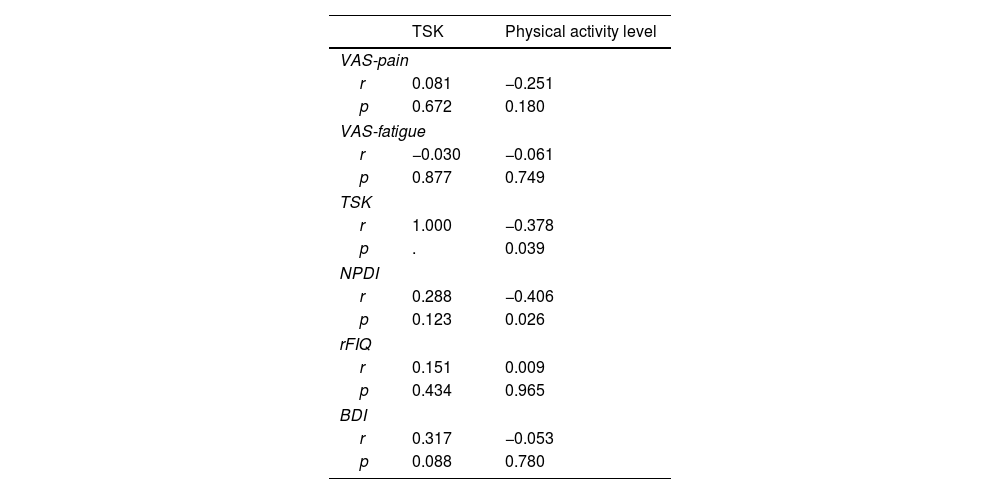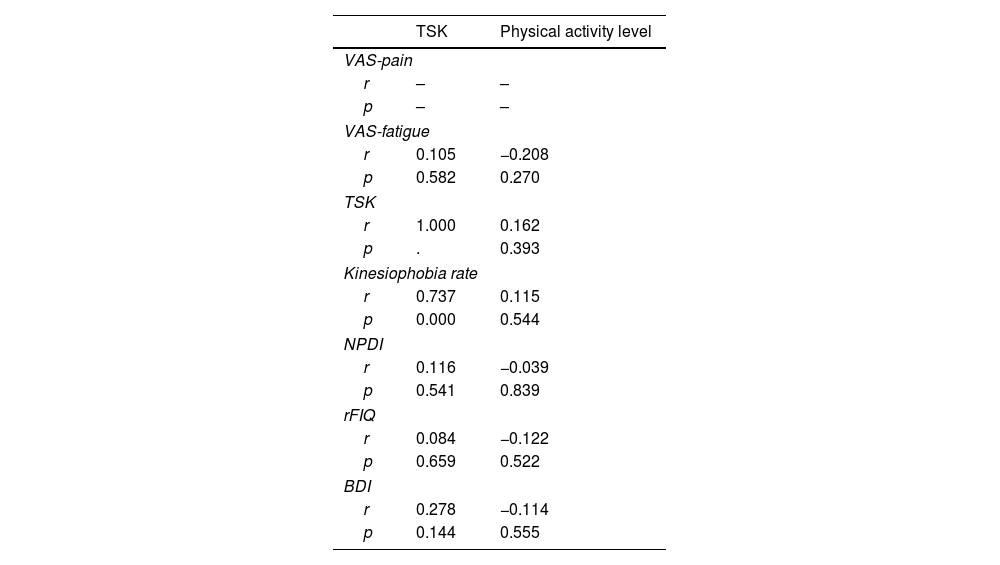We aimed to evaluate pain, kinesiophobia, physical activity, depression, disease severity and fatigue in patients with Fibromyalgia syndrome (FMS) and chronic neck pain (CNP) and healthy controls.
Material and methodsFifty-two patients with FMS (group 1), 52 patients with CNP (group 2) and 52 healthy controls (group 3) were included in the study. Visual Analog Scale (VAS) was used to evaluate pain intensity and fatigue, Tampa Scale of Kinesiophobia (TSK) for kinesiophobia, Beck Depression Inventory (BDI) for depression, International Physical Activity Questionnaire (IPAQ) Short Form for physical activity level, Revised Fibromyalgia Impact Questionnaire (rFIQ) for functional status in FMS, and Neck Pain Disability Index (NPDI) for neck pain-related disability in patients with CNP.
ResultsThe mean age was similar in all three groups (42.96) and the ratio of female was higher in all three groups (94.2%, 90%, 88.6%). High level kinesiophobia was present in 86.6% of patients in group 1, 63.3% of patients in group 2 and 23.4% of participants in group 3 and statistically, kinesiophobia was more common in groups 1 than in groups 2 and 3 and in group 2 than in group 3. The rate of depression was 80%, 50% and 16% in groups 1, 2 and 3, respectively. In group 1, 70% of patients had low, 23.3% had moderate, and 6.6% had high physical activity levels. In group 2, 46.6% of patients had low, 36.6% had moderate, and 16.6% had high physical activity levels; in group 3, 23.3% had low, 53.4% had moderate, and 23.3% had high physical activity levels. There was a statistically significant difference in physical activity levels among the three groups and between group 1 and group 3 (p<0.05), but no statistically significant difference was revealed in the remaining paired comparisons (p>0.05). TSK score was positively and weakly correlated with VAS-pain (p:0.032, r:0.392) and rFIQ scores (p:0.025, r:0.408) in group 1, positively and strongly correlated with BDI scores (p:0.002, r:0.547) in group 1, and negatively and weakly correlated with physical activity levels (p:0.039, r: −0.378) in group 2.
ConclusionsThe patients with group 1 and group 2 had higher levels of kinesiophobia, pain intensity, fatigue and a lower physical activity level than group 3.
Nuestro objetivo fue evaluar el dolor, la kinesiofobia, la actividad física, la depresión, la gravedad de la enfermedad y la fatiga en pacientes con síndrome de fibromialgia (FMS) y dolor cervical crónico (CNP) y en controles sanos.
Material y métodosSe incluyeron en el estudio 52 pacientes con FMS (grupo1), 52 pacientes con CNP (grupo2) y 52 controles sanos (grupo3). Se utilizó la Escala Visual Analógica (EVA) para evaluar la intensidad del dolor y la fatiga, la Escala de Tampa de Kinesiofobia (TSK) para la kinesiofobia, el Inventario de Depresión de Beck (BDI) para la depresión, el Cuestionario Internacional de Actividad Física (IPAQ) Versión Abreviada para el nivel de actividad física, el Cuestionario de Impacto de la Fibromialgia revisado (rFIQ) para el estado funcional en FMS y el Índice de Discapacidad por Dolor de Cuello (NPDI) para la discapacidad relacionada con el dolor de cuello en pacientes del grupo2.
ResultadosLa edad media fue similar en los tres grupos (42,96), y la proporción de mujeres fue mayor en los tres grupos (94,2%, 90% y 88,6%). La kinesiofobia de alto nivel estuvo presente en el 86,6% de los pacientes del grupo1, en el 63,3% de los pacientes del grupo2 y en el 23,4% de los participantes del grupo3, y, estadísticamente, la kinesiofobia fue más común en el grupo1 que en los grupos2 y3, y en el grupo2 que en el grupo3. La tasa de depresión fue del 80%, del 50% y del 16% en los grupos1, 2 y3, respectivamente. En el grupo1, el 70% de los pacientes tenían niveles de actividad física bajos, el 23,3% moderados y el 6,6% altos. En el grupo2, el 46,6% de los pacientes tenían niveles de actividad física bajos, el 36,6% moderados y el 16,6% altos. En el grupo3, el 23,3% tenían niveles bajos de actividad física, el 53,4% moderados y el 23,3% altos. Hubo una diferencia significativa en los niveles de actividad física entre los tres grupos y entre el grupo1 y el grupo3 (p<0,05), pero no se reveló ninguna diferencia significativa en las comparaciones pareadas restantes (p>0,05). La puntuación TSK se correlacionó positiva y débilmente con las puntuaciones VAS-dolor (p=0,032, r: 0,392) y rFIQ (p=0,025, r: 0,408) en el grupo1, se correlacionó positiva y fuertemente con las puntuaciones BDI (p=0,002, r: 0.547) en el grupo1, y se correlacionó negativa y débilmente con los niveles de actividad física (p=0,039, r: −0,378) en el grupo2.
ConclusionesLos pacientes con grupo1 y del grupo2 tenían niveles más altos de kinesiofobia, intensidad del dolor y fatiga, y un nivel de actividad física más bajo que los controles sanos.
Fibromyalgia syndrome (FMS) is a condition that generally affects young adult women aged 20–55 years, with a prevalence of 2–3% in the general population and unknown etiology. FMS has a wide range of other symptoms, including sleep disorder, fatigue, depression, anxiety, cognitive impairment, headache, and gastrointestinal complaints in addition to the widespread pain in the body.1 It has been reported that patients with FMS who have more severe fatigue-related symptoms may suffer more from physical and mental health problems related to quality of life.2 Although exercise has an important role in the treatment of FMS, the level of physical activity is reported to be lower in patients with FMS than in healthy controls. It is considered that reduced physical activity is caused by several factors, including fatigue, pain, and kinesiophobia. FMS patients with low levels of physical activity have been shown to have decreased pain threshold and inhibition, depression, pain catastrophizing, and fear of movement in addition to fatigue.3 Described as fear of movement, kinesiophobia refers to avoidance of physical activity due to excessive fear and anxiety concerning pain, which reduces mobility and muscle strength and triggers more fear of movement, and this vicious circle increases the risk of chronic pain. Patients with a high level of fear and anxiety were found to have more insomnia, catastrophic thoughts, disability, negative emotions, depression, high pain intensity, lower physical performance, reduced cognitive performance, and a lower quality of life in a study evaluating the fear of movement in FMS cases.4
Thirty to fifty percent of the general population experience neck pain, one of the most common musculoskeletal complaints, in their lifetime. Neck pain is a common symptom among office workers, of whom 50% associated this pain with their occupation and 14% stated that it restricted their daily life activities.5 It has been shown that the frequency and severity of neck pain are reduced in office workers who exercise or engage in sportive activities and that the risk of chronic pain increases in those that are physically inactive in general. Fear of movement caused by fear avoidance beliefs and behaviors results in restriction of physical activity and development of chronic pain, leading to depression, disability, and reduced job performance and quality of life in patients with neck pain.6 Determining the modifiable factors underlying kinesiophobia and reduced physical activity, such as depression and fatigue, will contribute to the development of targeted interventions that will optimize the rehabilitation process of patients. This study aims to directly guide clinical practice by emphasizing the necessity of multidisciplinary approaches in chronic pain management. In addition, revealing the interaction of these behavioral and psychosocial factors will form the basis for designing individualized treatment protocols in chronic diseases. We evaluated pain, kinesiophobia, physical activity, depression, disease severity, and fatigue in patients with FMS with a disease duration of longer than three months and chronic neck pain (CNP) lasting for more than three months, and healthy controls. We aimed to identify the factors related to kinesiophobia and restricted physical activity to take the necessary measures to prevent these behaviors in this study. These objectives aim to fill the gap in the current literature on how fear-avoidance behaviors and sedentary lifestyle associated with chronic pain trigger disease progression.
MethodsStudy designThis cross-sectional study was undertaken between July 2018 and July 2019. Written and verbal informed consent was obtained from all patients. The study protocol was approved by University Human Research Ethics Committee (2018/155). Patient enrollment start date: 01.10.2018, and ClinicalTrials.gov registration ID: NCT0377880.
PatientsFifty-two patients diagnosed with FMS according to the 2016 revised American College of Rheumatology (ACR) FMS diagnostic criteria with a disease duration of longer than three months; 52 patients with CNP lasting for more than three months, who had not undergone spinal surgery, and who did not have a metabolic, autoimmune, neurological, rheumatological disease and/or cancer, diagnosed by a Physical Medicine and Rehabilitation specialists; and 52 healthy controls without pain or additional disease, were included in the study, between July 2018 and July 2019. The exclusion criteria were malignancy, systemic infectious and rheumatic diseases, history of surgery, having received physical therapy or intra-articular or intraligamentary injection within the last three months, previous diagnosis of a psychological disorder, and current pregnancy. The study commenced after obtaining the approval of the local ethics committee and informed the consent of the participants.
All patients’ personal information (age, gender, occupation, education information), general health information (smoking and alcohol use information, known chronic disease history, body mass index), severity pain, and when it started were recorded. Pain intensity and fatigue were evaluated by the Visual Analog Scale (VAS), kinesiophobia by the Tampa Scale of Kinesiophobia (TSK), depression by the Beck Depression Inventory (BDI), physical activity level by the International Physical Activity Questionnaire (IPAQ) Short Form, functional status in patients with FMS by the Revised Fibromyalgia Impact Questionnaire (rFIQ), and neck pain-related disability in the neck pain group by the Neck Pain Disability Index (NPDI). The details of the implementation of the instruments are as follows:
Tampa Scale of Kinesiophobia (TSK)Based on a four-point Likert type, this scale contains 17 items that evaluate fear and anxiety related to physical activity. A total score of 37 or greater is accepted as statistically significant and interpreted as a high level of kinesiophobia. The validity and reliability analysis of the Turkish version of TSK was undertaken by Yilmaz et al.
Beck Depression Inventory (BDI)This is a 21-item questionnaire that investigates the characteristic attitudes and symptoms of depression. A score of 10 or higher indicates depression.
International Physical Activity Questionnaire (IPAQ) short formIPAQ consists of seven items that measure the duration of the participants’ physical activity, walking and sitting within the last seven days in the MET-min/week unit.
Visual Analog Scale (VAS) for the evaluation of pain and fatigueFor this evaluation, the patient is asked to mark his/her severity of pain and fatigue on a horizontal 10-cm line with number 0 on one end representing “no pain or no fatigue” and number 10 on the other end indicating “very severe pain or very severe fatigue”.
Revised Fibromyalgia Impact Questionnaire (rFIQ)rFIQ aims to measure FMS patient status, progress and outcomes through 21 questions that inquire about physical functions, work-related situations, depression, anxiety, waking up tired, pain, stiffness, and fatigue. The validity and reliability of the Turkish version of rFIQ was tested by Ediz et al.
Neck Pain Disability Index (NPDI)This index consists of 20 questions that assess severity of neck pain and the extent to which the pain affects the social, professional and daily activities of patients.
Statistical analysisStatistical analysis was performed using the Statistical Package for the Social Sciences (SPSS) v. 15.0. Descriptive statistics were given as mean±standard deviation (SD) for variables with normal distribution, and frequency tables for ordinal and categorical variables. We chose to conduct the Kolmogorov–Smirnov test for the normalization analysis. The Mann–Whitney U test was employed for paired comparisons of non-parametric numerical variables, Chi-square test for the paired comparison of categorical sociodemographic data and the comparison of sociodemographic data (except age and disease duration) between three groups, and one-way analysis of variance (ANOVA) for the comparison of parametric numerical variables like as age and disease duration between the three group. Before conducting one-way ANOVA, the Levene test was performed to test the homogeneity of variance. Since the result of this test was p<0.05 for VAS-fatigue, TSK and BDI, the Tukey test was employed for post hoc analysis. For VAS-pain and rFIQ that produced p<0.05 in the Levene test, the Games-Howell post hoc test was preferred. Spearman's correlation analysis was undertaken individually for each group. The level of statistical significance was accepted as p<0.05.
ResultsFifty-two patients with FMS (group 1), 52 patients with CNP (group 2) and 52 healthy controls (group 3) were included in the study. The mean age was 42.96±10.88, 38.50±11.65 and 35.40±9.95 in group 1, 2 and 3, respectively. In group 1, 94.2% of the patients were female and 5.8% were male; in group 2, 90% of the patients were female and 10% were male; and in group 3, 88.46% of the participants were female and 11.54% were male. Table 1 presents the sociodemographic data related to all participants.
Sociodemographic data of the patients with FMS and CNP and healthy controls.
| Group 1 (n=52) | Group 2 (n=52) | Group 3 (n=52) | p1 | p2 | p3 | p4 | |
|---|---|---|---|---|---|---|---|
| Age (years) Mean±SD | 42.96±10.88 | 38.50±11.65 | 35.40±9.95 | 0.024 | ns | ns | 0.031 |
| Gender (Female ratio) n (%) | 48 (94.2) | 47 (90.38) | 46 (88.46) | 0.034 | ns | ns | 0.025 |
| Marital status (Married ratio) n (%) | 45 (86.6) | 36 (70) | 32 (63.3) | ns | ns | ns | |
| Educational status n (%) | 0.000 | 0.000 | 0.000 | 0.000 | |||
| No formal education | 3 (6.6) | 0 (0) | 0 (0) | ||||
| Primary education | 30 (60) | 8 (13.3) | 4 (6.6) | ||||
| High school | 13 (20) | 8 (13.3) | 0 (0) | ||||
| University | 6 (13.3) | 36 (73.3) | 48 (93.3) | ||||
| Employment n (%) | 0.000 | 0.035 | 0.000 | 0.000 | |||
| Unemployed | 44 (86.6) | 18 (33.3) | 4 (6.6) | ||||
| Desk job | 2 (3.3) | 20 (40) | 28 (53.3) | ||||
| Active physical job | 6 (10) | 14 (26.66) | 20 (40) | ||||
| Disease duration (years) Mean±SD | 2.16±2.69 | 4.55±5.90 | 0±0 | 0.000 | 0.000 | ns | 0.000 |
| Additional disease (present) n (%) | 24 (44.8) | 10 (20) | 0 (0) | 0.000 | 0.000 | 0.041 | 0.000 |
| Medication (present) n (%) | 26 (50.0) | 14 (23.3) | 0 (0) | 0.000 | 0.005 | 0.047 | 0.000 |
| Pregabalin | 10 (23.3) | 0 (0) | 0 (0) | ||||
| Duloxetine | 8 (13.3) | 0 (0) | 0 (0) | ||||
| SSRI | 0 (0) | 0 (0) | 0 (0) | ||||
| NSAID | 8 (13.3) | 14 (23.3) | 0 (0) | ||||
p1: Difference between group 1 and 3; p2: Difference between group 2 and 3; p3: Difference between group 1 and 2, p4; Difference between all three groups.
n: number, SD: standard deviation, SSRI: selective serotonin reuptake inhibitor, NSAID: non-steroid anti-inflammatory drug.
A high level of kinesiophobia was present in 86.6% of the patients in group 1, 63.3% of the patients in group 2, and 23.4% of the participants in group 3. The rate of depression was 80%, 50% and 16.7% in group 1, 2 and 3, respectively. The level of physical activity was low in 70%, moderate in 23.3% and high in 6.6% of the patients in group 1; low in 46.6%, moderate in 36.6% and high in 16.6% of the patients in group 2; and low in 23.3%, moderate in 53.4% and high in 23.3% of the participants in group 3. Concerning VAS-fatigue, TSK and rFIQ scores, and rate of depression there was a statistically significant difference between group 1 and 3; and group 2 and 3 (p<0.05), but no statistically significant difference was observed between group 1 and 2 in these parameters (p>0.05). The VAS-pain and BDI scores, and rate of kinesiophobia statistically significantly differed in all intergroup comparisons (p<0.05). NPDI was only evaluated in patients with group 2 and group 3 and a statistically significant difference was found between the two (p<0.05). In terms of the level of physical activity, there was a statistically significant difference between the three groups and between group 1 and 3 (p<0.05), but the remaining paired comparisons did not reveal any statistically significant difference (p>0.05). Descriptive data of the groups are given in Table 2.
Descriptive data of the groups.
| Group1 (n=52) | Group 2 (n=52) | Group 3 (n=52) | p1 | p2 | p3 | p4 | |
|---|---|---|---|---|---|---|---|
| VAS-pain (Mean±SD) | 75.83±27.26 | 50.33±23.85 | 0±0 | 0.000 | 0.000 | 0.001 | 0.000 |
| VAS-fatigue (Mean±SD) | 74.66±28.37 | 64.33±24.59 | 41.66±23.05 | 0.000 | 0.002 | 0.263 | 0.000 |
| TSK (Mean±SD) | 41.70±6.30 | 38.33±7.98 | 30.83±8.84 | 0.000 | 0.000 | 0.332 | 0.000 |
| Kinesiophobia rate n (%) | 44 (86.6) | 30 (63.3) | 12 (23.4) | 0.000 | 0.000 | 0.037 | 0.000 |
| BDI (Mean±SD) | 18.37±8.07 | 12.03±7.09 | 5.44±5.68 | 0.000 | 0.002 | 0.002 | 0.000 |
| Depression rate n (%) | 42 (80) | 26 (50) | 8 (16.7) | 0.000 | 0.003 | 0.080 | 0.000 |
| Physical activity level n (%) | 0.000 | 0.166 | 0.167 | 0.003 | |||
| Low | 37(70) | 25 (46.6) | 13(23.3) | ||||
| Moderate | 11 (23.3) | 19 (36.6) | 26(53.4) | ||||
| High | 4 (6.6) | 8 (16.6) | 13(23.3) | ||||
| rFIQ (Mean±SD) | 49.79±22.60 | – | 13.79±10.17 | 0.000 | 0.000 | 0.450 | 0.000 |
| NPDI (Mean±SD) | – | 49.06±21.65 | 6.16±10.21 | – | 0.005 | – | – |
p1: Difference between group 1 and 3; p2: Difference between group 2 and 3; p3: Difference between group 1 and 2; p4: Difference between all three groups.
VAS: Visual Analog Scale, rFIQ: Revised Fibromyalgia Impact Questionnaire, NPDI: Neck Pain Disability Index, n: number.
When individuals with a high level of kinesiophobia and those with a lower level of kinesiophobia were compared in terms of the VAS-pain, VAS-fatigue, BDI, rFIQ, NPDI and TSK scores, physical activity level, and rates of depression and kinesiophobia within all three groups, no statistically significant difference was found (p>0.05). There was also no statistically significant difference in any of these parameters between individuals with different levels of physical activity in groups 1 and 3 (p>0.05). However, in group 2, a statistically significant difference was observed in NPDI between patients with low and moderate levels of physical activity (59.64±19.79 and 36.90±18.97, respectively; p=0.020) and those with moderate and high (46.20±20.43) levels of physical activity (p=0.020).
No statistically significant relationship was found between TSK score and VAS-pain, VAS-fatigue, NPDI, rFIQ, BDI and level of physical activity in patients with group 2. In patients with group 1, TSK score was only strongly related to BDI score (p:0.002, r:0.547), but not to VAS-pain, VAS-fatigue, rFIQ, BDI and level of physical activity. No statistically significant relationship was detected between TSK score and VAS-pain, VAS-fatigue, NPDI, rFIQ, BDI and level of physical activity in group 3 (Tables 3–5).
The results of Spearman's correlation analysis for the patients withgroup 1.
| TSK | Physical activity level | |
|---|---|---|
| VAS-pain | ||
| r | 0.392 | 0.133 |
| p | 0.032 | 0.483 |
| VAS-fatigue | ||
| r | 0.338 | 0.185 |
| p | 0.068 | 0.328 |
| TSK | ||
| r | 1.000 | 0.034 |
| p | . | 0.858 |
| High level kinesiophobia | ||
| r | 0.557 | 0.056 |
| p | 0.001 | 0.767 |
| rFIQ | ||
| r | 0.408 | −0.012 |
| p | 0.025 | 0.951 |
| BDI | ||
| r | 0.547 | 0.097 |
| p | 0.002 | 0.616 |
VAS: Visual Analog Scale, TSK: Tampa Scale of Kinesiophobia, BDI: Beck Depression Inventory, rFIQ: Revised Fibromyalgia Impact Questionnaire.
The results of Spearman's correlation analysis for the patients with group 2.
| TSK | Physical activity level | |
|---|---|---|
| VAS-pain | ||
| r | 0.081 | −0.251 |
| p | 0.672 | 0.180 |
| VAS-fatigue | ||
| r | −0.030 | −0.061 |
| p | 0.877 | 0.749 |
| TSK | ||
| r | 1.000 | −0.378 |
| p | . | 0.039 |
| NPDI | ||
| r | 0.288 | −0.406 |
| p | 0.123 | 0.026 |
| rFIQ | ||
| r | 0.151 | 0.009 |
| p | 0.434 | 0.965 |
| BDI | ||
| r | 0.317 | −0.053 |
| p | 0.088 | 0.780 |
VAS: Visual Analog Scale, TSK: Tampa Scale of Kinesiophobia, rFIQ: Revised Fibromyalgia Impact Questionnaire, NPDI: Neck Pain Disability Index, BDI: Beck Depression Inventory.
The results of Spearman's correlation analysis for the group 3.
| TSK | Physical activity level | |
|---|---|---|
| VAS-pain | ||
| r | – | – |
| p | – | – |
| VAS-fatigue | ||
| r | 0.105 | −0.208 |
| p | 0.582 | 0.270 |
| TSK | ||
| r | 1.000 | 0.162 |
| p | . | 0.393 |
| Kinesiophobia rate | ||
| r | 0.737 | 0.115 |
| p | 0.000 | 0.544 |
| NPDI | ||
| r | 0.116 | −0.039 |
| p | 0.541 | 0.839 |
| rFIQ | ||
| r | 0.084 | −0.122 |
| p | 0.659 | 0.522 |
| BDI | ||
| r | 0.278 | −0.114 |
| p | 0.144 | 0.555 |
VAS: Visual Analog Scale, TSK: Tampa Scale of Kinesiophobia, rFIQ: Revised Fibromyalgia Impact Questionnaire, NPDI: Neck Pain Disability Index, BDI: Beck Depression Inventory.
The rate of patients with kinesiophobia in patients with group 1 and group 2, the severity of kinesiophobia, and the severity of fatigue were statistically significantly higher than in the control group, but there was no statistically significant difference between the two groups in this study. In addition, the rate of kinesiophobia was found to be higher in patients with group 2 who had low physical activity levels. The rate of depression was higher in patients with group 1 than in those with group 2 and in group 3. In addition, there was a strong relationship between kinesiophobia and depression in patients with group 1. Although physical activity levels were lower in those with group 1 than in group 3, they were similar in those with group 2 and group 1.
The mean age and female-male ratio of the group 1 patients included in the study were consistent with other studies in the literature.1 However, the percentage of participants in employment was much lower in the current study (13.3%) compared to the reports of Russek et al. (46.8%)7 and Schaefer et al. (49%)8 for FMS patients. The mean age of our patients with group 2 was similar to that in the literature, but our female-male ratio in this patient group was higher than previously reported. In this regard, our results support those of Wijnhoven et al.,9 who found that the prevalence of neck pain in women was higher than men. In a study conducted on patients with total knee arthroplasty, kinesiophobia was found to be more common in unemployed or retired patients.10 The prevalence and influencing factors of kinesiophobia in patients with heart disease were examined in a systematic review published in China in 2024, and unemployment was reported to be a risk factor for kinesiophobia.11 The overall rate of employment and rate of employment in jobs requiring physical work were much lower in the group 1 and group 2 group compared to the group 3. The level of education was similar between the patients with neck pain and group 3, but was statistically significantly lower in patients with group 1 than in the other two groups. The FMS patients with a lower level of education had a higher level of pain severity, fatigue, depression and kinesiophobia and lower level of physical activity, and the group 3with a higher level of education had a lower level of pain severity, fatigue, kinesiophobia and depression, which suggests that these conditions are associated with educational level.12 The most frequently used drugs in patients with FMS were found to be; non-steroidal anti-inflammatory drugs (NSAIDs) 41.0%, selective serotonin noradrenaline reuptake inhibitors (SNRIs) 11.5%, pregabalin 5.1%, selective serotonin reuptake inhibitors 1.3% in the study by H-C Aster et al.13 Unlike this study, 23.3% of the patients used pregabalin, 13.3% Duloxetine, and 13.3% NSAIDs in our study. This difference may be due to the old age of the study, the increased use of pregabalin and duloxetine in fibromyalgia over time, and the decrease in drug use due to non-drug alternative treatments.
Fear of movement in patients with FMS has been evaluated using TSK in the literature. Similar to studies in literature, we classified those with a TSK score greater than 37 as having high levels of kinesiophobia.14 Van Koulil et al.15 reported that 40% of 359 FMS patients; Turk et al.16 reported that 39% of 233 FMS patients; Russek et al.7 reported that 72.9% of 1125 FMS patients; Demirbüken et al.17 reported that 80.2% in 99 patients with CNP, had high-level kinesiophobia. Similarly, in our study, 86.6% of group 1 patients, 63.3% of group 2 patients, and 23.4% of group 3 had high-level kinesiophobia. The rate of high level of kinesiophobia was higher in our group 1 compared to the literature. The high rate of kinesiophobia in the group 1group may have been due to the high rate of women (94.2%), the high rate of those with low education (66.6%), and the high rate of unemployed individuals (86.6%) in our study. The mean TSK score obtained from the CNP group in the current study was similar to that reported by Cheung et al.,18 who evaluated 19 patients with CNP and 21 healthy controls. We also found that the group 1 and group 2 had a higher mean TSK score and rate of high-level kinesiophobia than the control group. Although there was no statistically significant difference in the TSK scores between the group 1 and group 2, the former had a slightly higher rate of high-level kinesiophobia than the latter. However, we detected no statistically significant difference in pain severity, fatigue, depression, rFIQ and NPDI score, physical activity level, or kinesiophobia between the participants with a high or low level of kinesiophobia in any of the three groups. There was a strong relationship between kinesiophobia and depression in patients with group 1. Depression accompanying FMS can cause kinesiophobia, and kinesiophobia that accompanying FMS can cause depression, or they can increase the severity of each other.19,20 Therefore, we recommend that patients with FMS who have kinesiophobia be questioned for the presence of accompanying depression.
Previous studies reported that the severity of pain was higher in female patients with FMS who had kinesiophobia.21 Demirbüken et al.17 found no statistically significant relationship between neck pain severity and kinesiophobia, whereas Cheung et al.18 showed a weak correlation between the two. We determined that pain severity was higher in the group 1and group 2 than in the control group and in the group 1, group compared to the group 2 in the current study.
Crawford et al.22 evaluated fatigue in 1121 FMS patients (90% female) using VAS and showed that this was a valid and reliable instrument for this type of assessment in this patient group. The authors reported the VAS-fatigue and VAS-pain scores of the FMS patients to be 72.86 and 71.84, respectively. In a study by Wolfe et al.,23 76% of the patients with FMS were found to have clinically statistically significant fatigue (VAS-fatigue score>20mm). Various other studies confirmed that the level of fatigue was higher in patients with CNP than in healthy controls, and there was a relationship between the severity of neck pain and level of fatigue.24 We also observed that the level of fatigue was statistically significantly higher in patients with group 1 and group 2 compared to the group 3, but with no statistically significant difference between these two groups in the current study. Chronic musculoskeletal pain and mood disorders such as depression may cause greater levels of fatigue in patients with FMS and CNP.4
The rate of depression is reported to be higher in patients with FMS than in healthy controls in the literature.25 Several researchers suggested that the rate of depression was higher in patients with group 2 and depression was associated with pain severity, disability, and kinesiophobia.26 Depression was present in 80% of patients with group 1, 50% of patients with group 2 and 16.7% of group 3 in the present study. We did not find any study that directly compared patients with group 2 and group 1 in patients in terms of depression. However, Madenci et al.,26 who comparatively evaluated patients with FMS and chronic pain, reported that the BDI score was 25.8±3.2 and 29.3±5.3 in the former and latter groups, respectively, and there was no statistically significant difference between the two groups. Although these scores are statistically significantly higher than those we obtained in our study, they support our finding that patients with group 1 and group 2 had higher BDI scores than the control group and those with group 1 had higher BDI scores than the group 2 group. Furthermore, we determined that depression was associated with kinesiophobia in patients with FMS, but no such relationship was present in the neck pain group.
Demirbüken et al. reported that,17 49.5% of the patients with CNP had a moderate level of physical activity, 42.9% had a high level of physical activity, and 7.7% had a low level of physical activity, and the rate of kinesiophobia and the TSK score were not associated with physical activity. Cheung et al.18 reported a negative correlation between physical activity level and kinesiophobia, but this did not reach statistical significance. The two previous studies comparing the level of physical activity between patients with CNP and healthy controls showed no statistically significant difference between the two in terms of physical activity level, which is consistent with our findings.
Merriwether et al.27 determined that FMS patients that completed IPAQ, 46.2%, 27.2% and 26.5% were found to have a low, moderate and high level of physical activity, respectively, and a negative and weak relationship was present between the TSK score and physical activity level. We found that physical activity level was lower in patients with group 1 compared to the group 3, but there was no statistically significant difference between the patients with neck pain and those with group 1 in our study. We also did not observe any statistically significant relationship between the TSK score and physical activity level in contrast to the literature.7,27 There was also no statistically significant difference in pain severity, fatigue, depression, kinesiophobia or rFIQ and NPDI scores between the patients with different levels of physical activity in the group 1 patients and healthy control groups. However, the rate of neck pain- related disability and kinesiophobia was higher in patients with a low level of physical activity compared to those with a moderate or high level of physical activity in the CNP group; and similarly, this rate was higher in patients with a high level of physical activity than those with a moderate activity level. Patients with low physical activity in patients with CNP were found to have higher neck pain-related disability than those with moderate to high values, and those with a high level of physical activity. We consider that excessive or heavy physical activity can trigger CNP and increase disability as much as a sedentary lifestyle according to this result. According to these data, we can say that moderate physical activity can reduce the risk of CNP; however, 40 randomized controlled trials were evaluated comparing physical exercise interventions for CNP in a systematic review conducted in 2021; it was reported that there was no superior type of physical exercise for people with CNP.28
Sivas et al.29 evaluated 80 patients with FMS and 46 healthy controls, and reported the mean rFIQ score as 57.45±15.23 and 15.77±11.40, respectively. The authors also stated that the FMS group had a higher level of pain severity, rFIQ score, and depression rate than the control group, and FMS-associated disability was correlated with pain severity and depression. Although the rFIQ scores we obtained were similar to those of Sivas et al.,29 they were lower than those reported by other researchers.7 We observed that rFIQ was higher in the group 1than in the healthy individuals but there was no statistically significant relationship with the scores of rFIQ, and pain severity and depression.
Cheung et al.18 found a much higher level of neck pain-associated disability in the former group in their comparison of 19 patients with neck pain and 21 healthy controls. Hernandez et al.,30 evaluated 97 patients with chronic mechanic neck pain, reported a correlation between neck pain-associated disability, pain severity, and kinesiophobia in another study. Although the NPDI and rFIQ scores were statistically significantly higher in the neck pain group compared to the group 3in the current study, rFIQ did not statistically significantly differ between the group 1 and neck pain groups. Furthermore, no such relationship was observed between disability and kinesiophobia despite neck pain associated disability was higher in CNP patients who engaged in low and high levels of physical activity than in those who engaged in moderate levels of physical activity.
The limitations of this study include the relatively small sample size, the existence of a difference in age and gender between group 1 and group 3, and the inability to make a comparison between groups 1 and 2 because the same criterion was not used in terms of “health status or function”. Additionally, the fact that the rates of medication use and the types of medications used were different between patients with group 1 and group 2 and that these could not be included in the statistical analysis may be one of the factors affecting the results of the study and is among the limitations of our study.
ConclusionsThis is the first study in the literature to compare pain severity, fatigue level, kinesiophobia, depression, and physical activity level between patients with FMS and CNP and healthy controls to the best of our knowledge. We found that both patient groups exhibited significantly higher levels of kinesiophobia and lower levels of physical activity compared to healthy individuals, and that depression and kinesiophobia were correlated in FMS. Future studies are needed focusing on early treatment protocols that will prevent the chronicity of pain and the potential of increased physical activity to break the vicious cycle of pain-immobility-kinesiophobia.
Authors’ contributionsMAS: Designing the study, collecting, analyzing the data, writing the manuscript; GDK: Analyzing the data, writing the manuscript; EM: Designing the study, analyzing the data and coordinating the study; BDÇ: Data collection & interpretation. All co-authors of the study take full responsibility for the integrity of the final version of the manuscript.
Ethics approval and consent to participateThe study protocol was approved by the Aksaray University Human Research Ethics Committee (2018/155). All procedures performed in studies involving human were in accordance with the ethical standards of the institutional research committee (Aksaray University Human Research Ethics Committee) and with the 1964 Helsinki Declaration and its later amendments or comparable ethical standards. Written and verbal informed consent was obtained from all patients.
Consent for publicationNot applicable.
FundingThis research received no specific grant from any funding agency in the public, commercial, or not-for-profit sectors.
Conflict of interestsThe authors declare no conflict of interest.
Availability of data and materialsThe authors confirm that the data supporting the findings of this study are available within the article.
Code availabilityN/A.
None.

